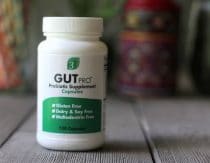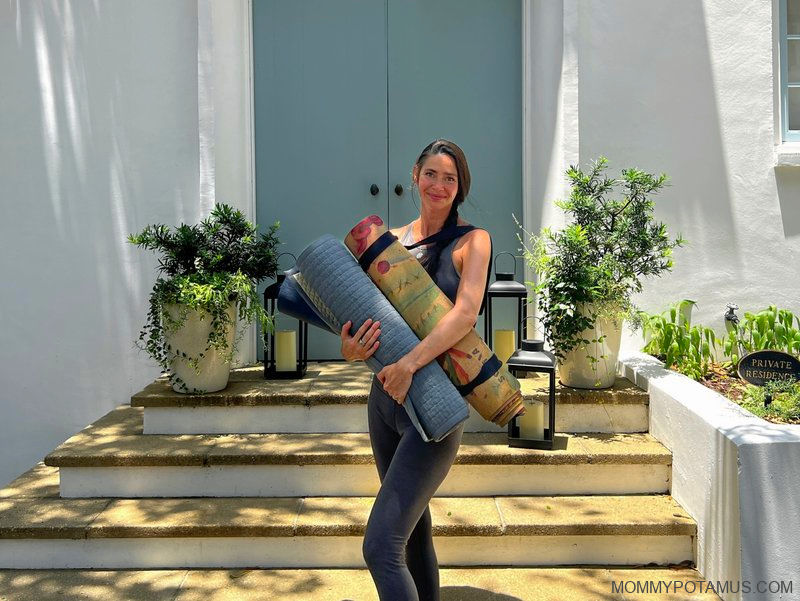
When I bought my first yoga mat many years ago, I didn’t think much about the materials it was made with. I figured that people who do yoga are generally health conscious, and would insist on non-toxic materials that support that goal.
Unfortunately, many popular yoga mat manufacturers use greenwashing techniques to make their products seem safe, natural and sustainable . . . . when in fact, testing shows that they’re pretty much the opposite.
According to an independent test conducted by Ecology Center, a non-profit organization, “some yoga mats marketed as eco-friendly were made of materials that present environmental and human health hazards.” (1)
Some were even completely mislabeled. For example, some mats marked as Polymer Environmental Resin (PER) were actually made of vinyl (PVC). (1)
Starting Over
Last summer, when my family discovered mold in our home, we had to throw away many of our personal possessions and move out for 3+ months. After working with HomeCleanse to remediate our house, we moved back in and began the process of replacing beloved belongings.
Daily stretching and/or yoga is a vital part of my wellness routine, so replacing my yoga mat was a top priority. My daughter also stretches daily – she says it makes her Oura ring happy – so I asked her to test a few mats with me.
Because we have so many personal items to replace, I researched materials extensively before deciding what to allocate our limited budget toward. After a lot of consideration, I chose one mat from each category of safe materials to test and review.
Weirdly, just getting to that point was much more difficult than I expected. Here’s why:
Finding out what’s in a yoga mat is trickier than it should be
Labeling practices can be seriously sneaky. For example, did you know that when a mat composition is listed as TPE (Thermoplastic Elastomer), that doesn’t describe what it’s actually made of?
Basically, labeling something as TPE is like labeling cake as “cake” without listing the actual ingredients that went into making it.
TPE is a general term for 6+ types of copolymers that have been manufactured to create a soft, rubbery surface. (2)
Each “recipe” is a little different, but hormone disrupting phthalates are often added because they make the mats more flexible. Styrene, which has been linked to cancer, is another common TPE compound. (3)(4)
Also, since manufacturers don’t have to disclose their entire formulas, they can potentially highlight some ingredients while leaving others out.
For example, a yoga mat “made with Forest Stewardship Council certified natural tree rubber” may also contain synthetic rubber, polyurethane, polyester, nylon, and an unspecified antimicrobial agent.
That’s an actual list of materials from a popular company that – to their credit – does disclose ingredients, but the main product description only says “Made With FSC™ Certified Rubber.”
Not all of those material are super concerning to me, but some are, which is why I think it’s important to always read the fine print.
Fortunately, some companies are transparent about the materials they use, and third party tests can help us fill in the gaps.
Here’s what I’ve learned, plus my top mat recommendations.
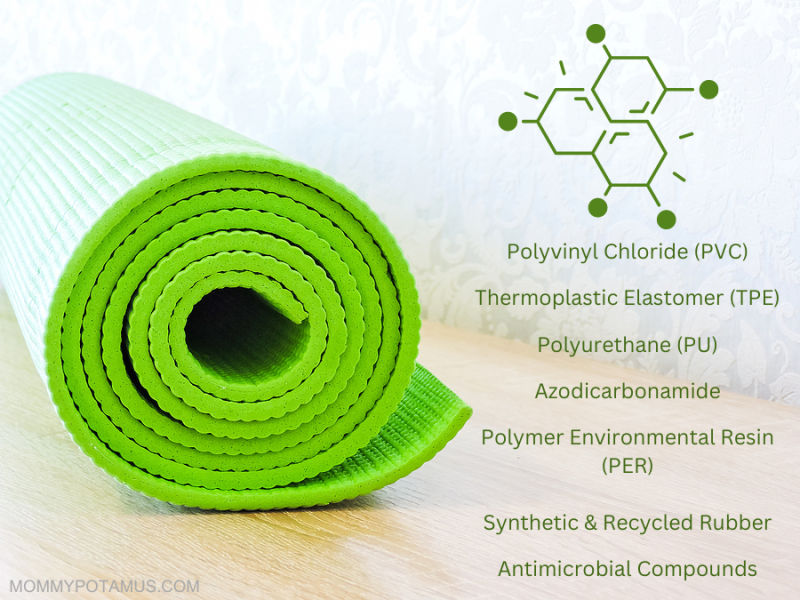
7 Materials To Avoid 🚫
Although often marketed as safe, even eco-friendly, here are seven materials I recommend avoiding if possible.
#1 – PVC
Most yoga mats are made with polyvinyl chloride (PVC) because it’s cheap, spongy, and grippy. If you’re thinking “Hey now, PVC pipes aren’t spongy and grippy,” you’re right.
It takes the addition of heat stabilizers, plasticizers, and lubricants to achieve those properties. Some common heat stabilizer options include:
- Lead
- Organotin compounds including mono-butyltin (MBT), dibutyltin (DBT) and tributyltin (TBT)
- Cadmium
- Antimony
- Organochlorines (5)
In terms of plasticizers, hormone disrupting phthalates are by far the most popular, but just because a yoga mat is labeled “phthalate-free” doesn’t necessarily mean it’s non-toxic.
Compounds that can be substituted for phthalates – trimellitates, sebacates and adipates, for example – have also been linked to negative health effects. (6) Others have virtually no safety data at all, so we really don’t know what their impact may be.
#2 – PER
PER (Polymer Environmental Resin) is PVC that has undergone extra processing to make it less toxic. While it’s better than plain PVC, I think less is the operative word. It’s not great for the environment, either, and there are more sustainable options available.
#3 – TPE
As I mentioned earlier, TPE is an umbrella term that doesn’t actually tell you what’s in the mat. And unfortunately, saying it is “free” of a particular chemical doesn’t mean a chemical with similar effects wasn’t used.
For example, one study showed that many “BPA-free” plastics (which would include TPE) actually contained more powerful endocrine disruptors than BPA. (7)
#4 – Synthetic Rubber & Recycled Rubber
Depending on what it was in its previous life, recycled rubber can contain a wide variety of contaminants including heavy metals and toxic chemicals. (8)
For example, lab testing conducted by the Ecology Center found that yoga mats made from recycled wetsuits contained phthalates. (1)
Synthetic rubber is also best avoided. It’s a petroleum-based compound that’s made with chemicals like 1,3-butadiene, a known human carcinogen. (9)
#5 – Mystery antimicrobial compounds
Remember when toy companies infused their products with triclosan and told us it would make kids healthier? (10) Years later, it was banned from use in soap after it was linked with impaired thyroid function, gut inflammation, antibiotic resistance, and possibly skin cancer. (11) (12)
Unfortunately, it’s still legal to use triclosan in consumer products that fall outside of the FDAs jurisdiction – including toys and yoga mats – and it’s definitely still happening. (13) (14)
My recommendation is to choose naturally antimicrobial materials and skip vaguely disclosed synthetic additives.
#6 – Polyurethane (PU)
Polyurethane foam is generally considered a safer type of plastic, but because it’s flammable it often contains added flame retardants. One type of flame retardant commonly used in yoga mats – organophosphate flame retardants (PFRs) – has been found to negatively impact female fertility. (15) (16)
#7 – Azodicarbonamide (The “Yoga Mat Chemical”)
This is a foaming agent that is used in the United States as a food and consumer product additive. It’s added to yoga mats to make them spongy. However, it’s banned as a food additive in Europe because it can break down into carcinogenic compounds when it degrades.
I haven’t been able to find any information on whether azodicarbonamide breaks down through regular use of yoga mats – especially if heat or outdoor light are factored in – so it’s on my avoid list for now.
🔍 What To Look For
I’ll share my top recommendations in the next section, but if you want to shop around and compare here’s what to look for:
Natural tree rubber
Pros:
✅ Good comfort/cushioning (how much depends on mat depth)
✅ Good grip when dry
✅ Easy to clean
✅ Sustainable, recyclable, biodegradable
Cons:
❌ Not recommended for anyone with a latex allergy
❌ Heavier than some options
❌ Can become slippery when wet (use a towel to wipe away sweat if needed)
Natural Cork
Pros:
✅ Provides good grip that improves with moisture (like sweat). Perfect for all types of sessions, including everything from light stretching to hot yoga
✅ Naturally antimicrobial
✅ Easy to clean
✅ Sustainable, biodegradable
Cons:
❌ Heavier than some options (like cotton)
❌ Not super spongy, so usually paired with another material to add cushion (natural rubber is a good choice)
❌ Can crack if folded
Organic cotton
Pros:
✅ Washable
✅ Absorbs sweat (helpful for maintaining grip during a session)
✅ Sustainable, recyclable and biodegradable
Cons:
❌ May slip around on the floor (which is why some are paired with a grippy rubber backing)
❌ Some are thin and don’t provide a lot of cushion
Jute
Pros:
✅ Natural antimicrobial
✅ Sustainable and biodegradable
Cons:
❌ Can be slippery when dry, so it’s often combined with PVC or Polymer Environmental Resin (PER) for extra grip
❌ Not much cushion unless combined with another material
🧘🏻♀️ The 5 Best Non-Toxic Yoga Mats
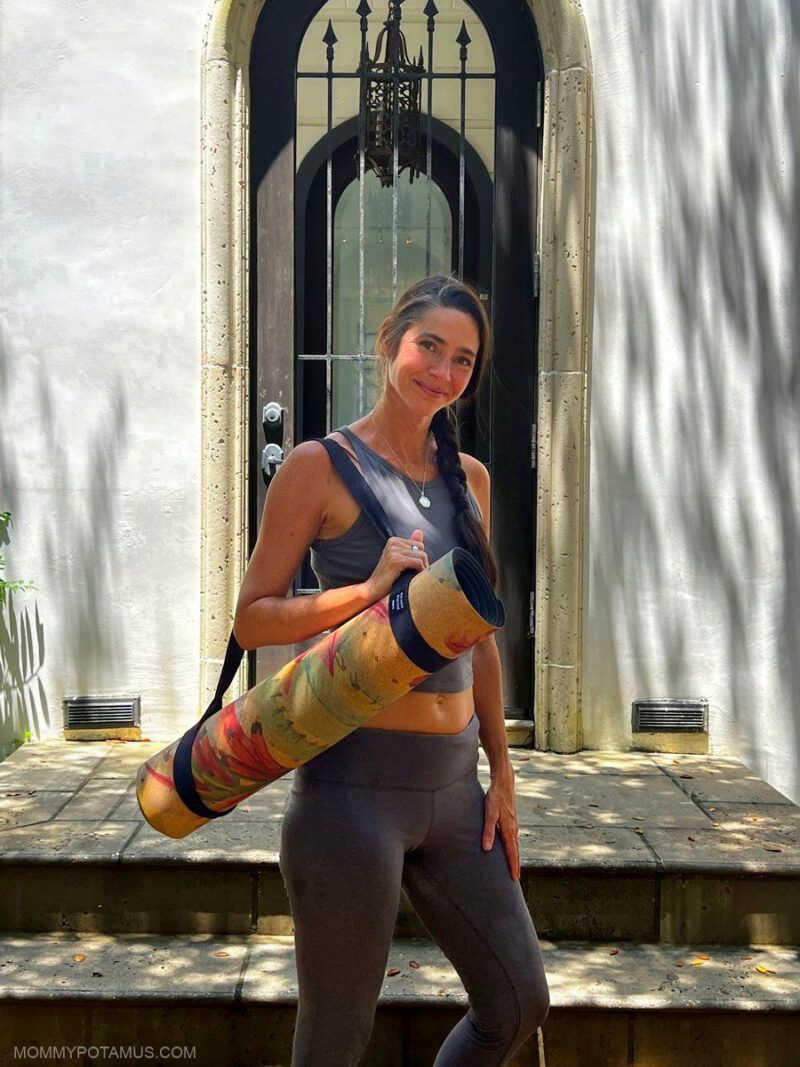
I’ve found a couple of mats that hit the “sweet spot” in terms of safety and comfort, while others are natural but not comfy, or a little less natural but more comfy.
Here are my top recommendations for performance, comfort, and safety.
#1 – Scoria
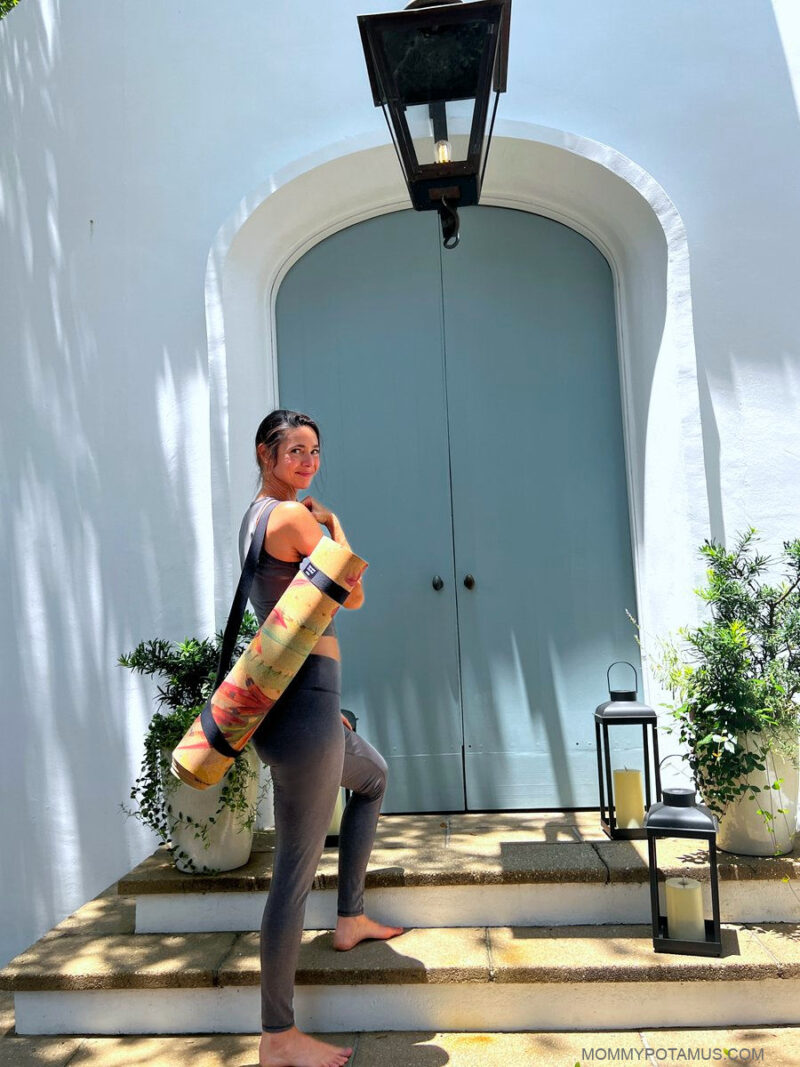
Beautiful and comfortable, Scoria’s natural cork mats come with a natural rubber backing that’s bonded to the cork grains with water-based eco adhesives.
My new 4.5 mm thick botanical mat is thinner than my old spongy mat, so I was worried that it might be uncomfortable. It’s not, though. It cushions instead of compressing under my weight like my previous mat, so I’m able to comfortably enjoy sessions on both tile and wood floors.
If you prefer an extra thick mat for maximum cushion, they have a few options:
- Extra Thick 6mm Botanical Mat
- Extra Thick 6mm & Wide Botanical Mat
- Extra Thick 6mm Essential Cork Mat
- Extra Thick & Wide Essential Cork Mat
- Extra Thick 6mm Tree of Life Mat
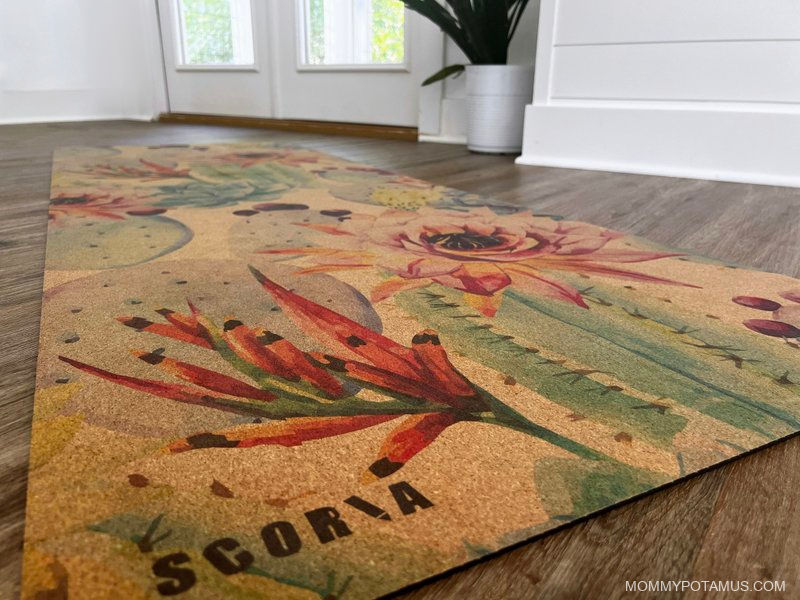
Pros:
✅ Non-slip backing is made with natural tree rubber instead of TPE/PVC (like some other cork mats)
✅ Grippy when dry or wet. No towel needed, even during hot yoga.
✅ Wide variety of designs
✅ Naturally antimicrobial
✅ Easy to clean (Just wipe with a damp cloth. You can use a little soap and water if desired)
✅ Sustainably harvested
✅ Comes with a 1 year limited warranty
Cons:
❌ Cork may crack if you fold it instead of rolling it as recommended. Make sure to roll it with the cork facing out instead of folding.
Click here and use code MP10 to save 10%
#2 – Manduka eKO
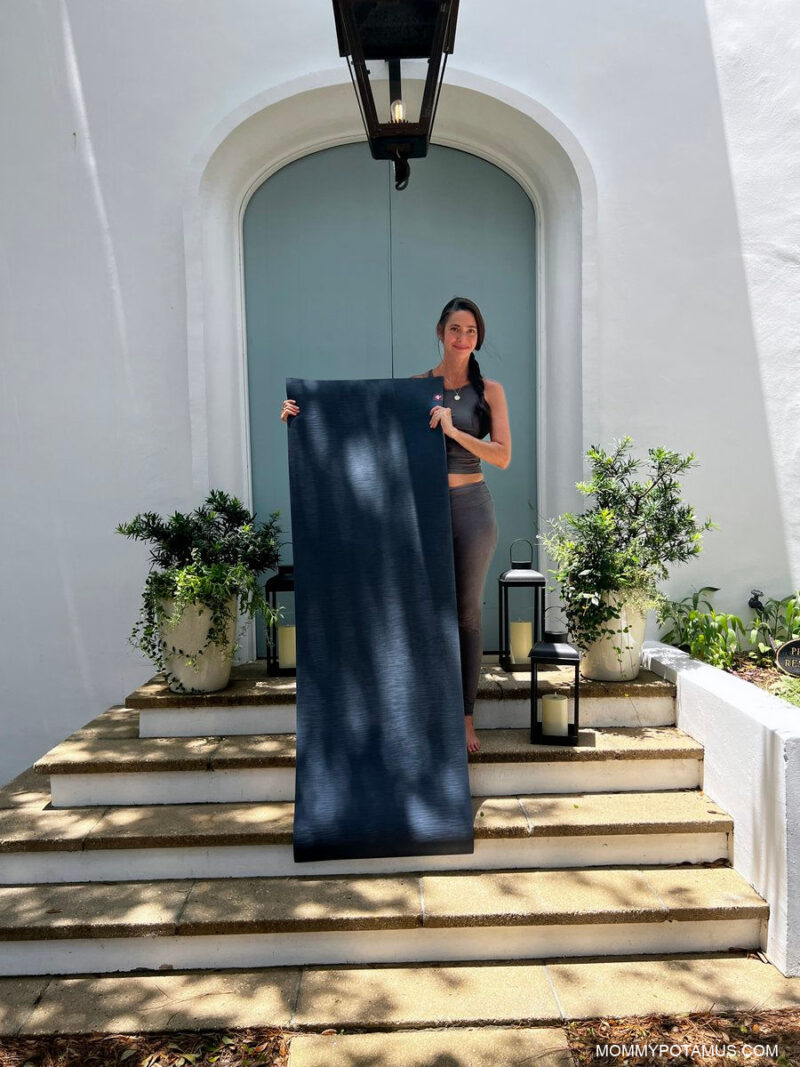
If you’re looking for a 100% natural rubber mat, the Manduka eKO comes pretty close. It’s made with natural rubber, a small amount of cotton and polyester, and non-azo dyes.
My favorite thing about this mat is that it’s grippy, even when completely dry. My least favorite thing is that it smells strongly of natural rubber at first. It’s fine after it airs out for a bit, though.
One quick note: Only the eKO original, eKO Lite and eKO Superlite are made with natural natural rubber. Other popular Manduka products, like the Manduka Pro are made with PVC.

Pros:
✅ Made with natural tree rubber
✅ Rippled surface texture to increase grip
✅ Good cushion
Cons:
❌ Has a very strong natural rubber scent (fades with time)
❌ You may need to use a towel during hot yoga sessions to keep the mat from becoming slippery
Click here to check out the Manduka eKO
#3 – Organic Cotton Yoga Mat from Brentwood Home
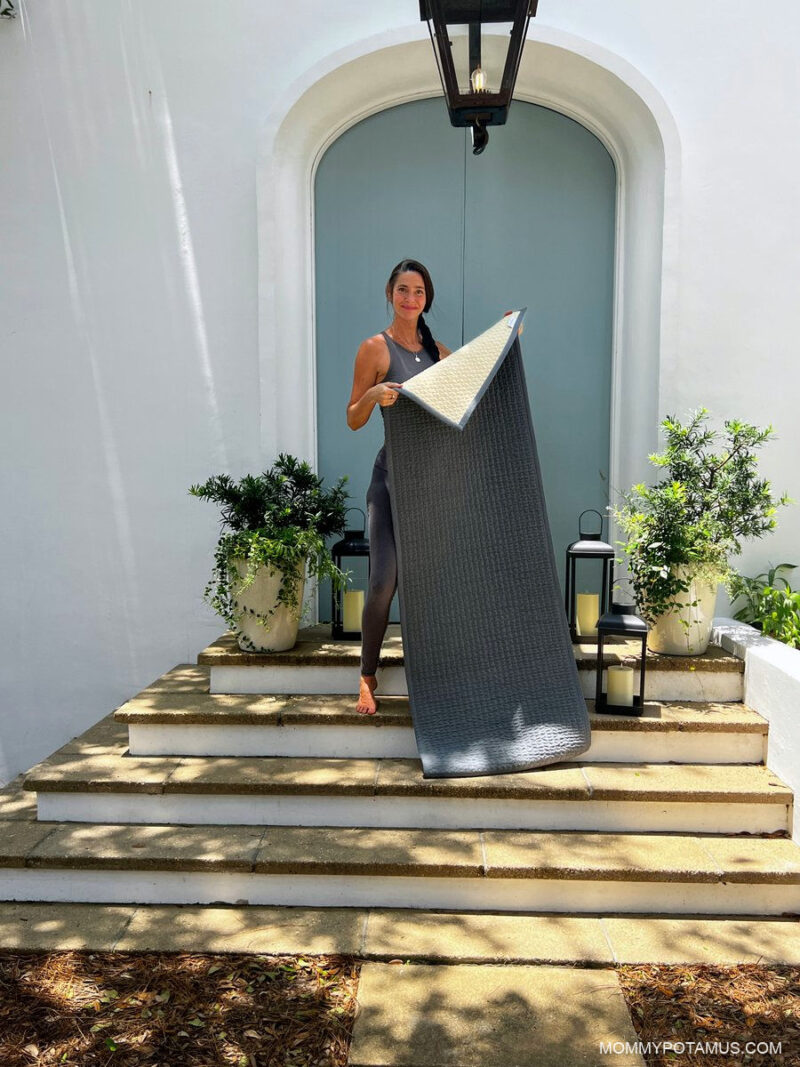
Cotton yoga rugs are the original yoga mats, and Brentwood home has improved on the design with the addition a non-slip natural rubber backing.
This washable mat is made with the good stuff: GOTS-certified organic cotton and GOTS and FSC®-certified natural Dunlop latex – with no polyurethane foam, PVC, PER, TPE, EVA, synthetic rubbers, or adhesives.
Although it’s about as thick as the two mats above, cotton doesn’t provide as much cushion as cork and rubber. For that reason, I recommend this mat for use over area rugs or carpet.
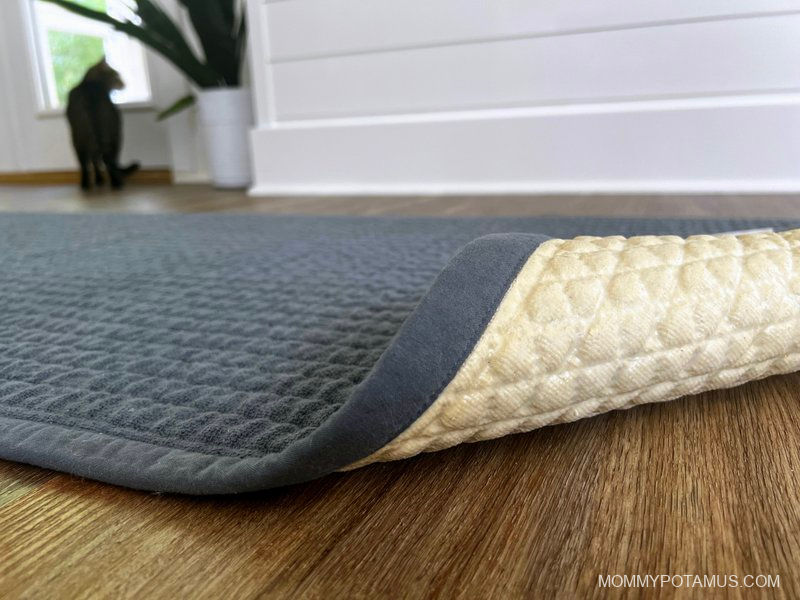
Pros:
✅ One of the world’s only GOTS-certified organic yoga mats
✅ Washable
✅ Absorbent
✅ Biodegradable
✅ Comes in several beautiful colors
Cons:
❌ When the fabric is dry it’s not as grippy as, say, rubber, which can make it challenging to hold poses that require a lot of traction. However, it’s often used for hot yoga because the wetter the fabric gets the better the grip becomes.
❌ May need to spritz it with water to make it more grippy for intense sessions
Click here to shop Brentwood Home
#4 – Gurus Roots
This is a highly rated sustainable cork and natural tree rubber mat, but it’s but often out of stock. I chose to test the Scoria because I wanted a mat with a bit of color, but if you prefer a minimalist design this is a great option. I recommend the original cork mat and not The Sprout, which is made with TPE.
Click here to shop Gurus Roots
#5 – Jade Organic Cotton Mysore Rug
This machine washable rug can be a good option if you’re practicing outside on soft areas like grass or sand.
Click here to check out the Jade Organic Cotton Mysore Rug
More Reviews & Recommendations
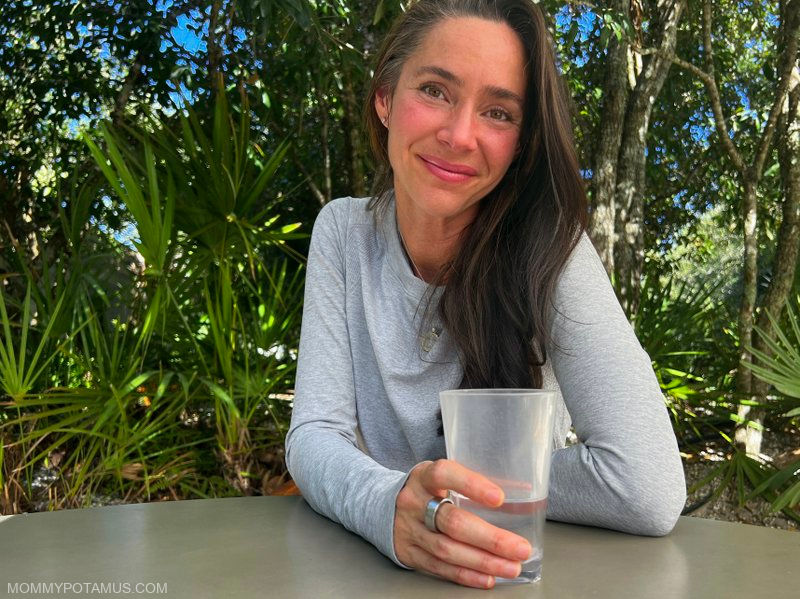
Oura Ring Review: My Thoughts After 5+ Years – Oura offers clear insights that take a lot of the guesswork out of what’s working for me (and what’s not).
In this review, I talk about:
- How it helps me make real-time decisions that support my health goals
- Features like period prediction and the ability to measure blood oxygen levels throughout the night
- Comfort and durability
- Why I prefer it to other sleep and fitness trackers and so much more
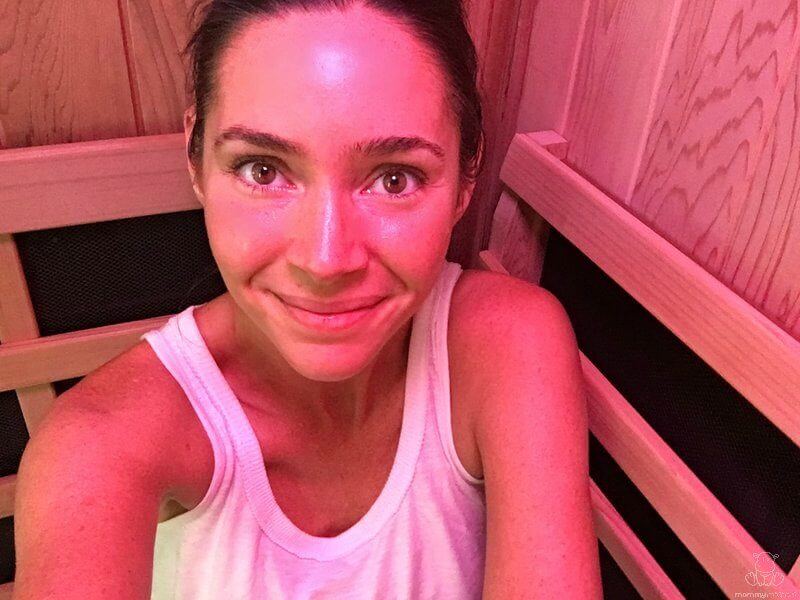
Clearlight Infrared Sauna – Incorporating sauna therapy into my life is one of the BEST things I have ever done for my health. I can:
- increase my metabolism
- activate collagen production
- read a chapter to my littles (they like to visit)
- take my stress levels down 10 notches
- support detoxification
- activate heat-shock proteins associated with longevity
. . . and think more clearly in just 30 minutes a day – all while sitting down.
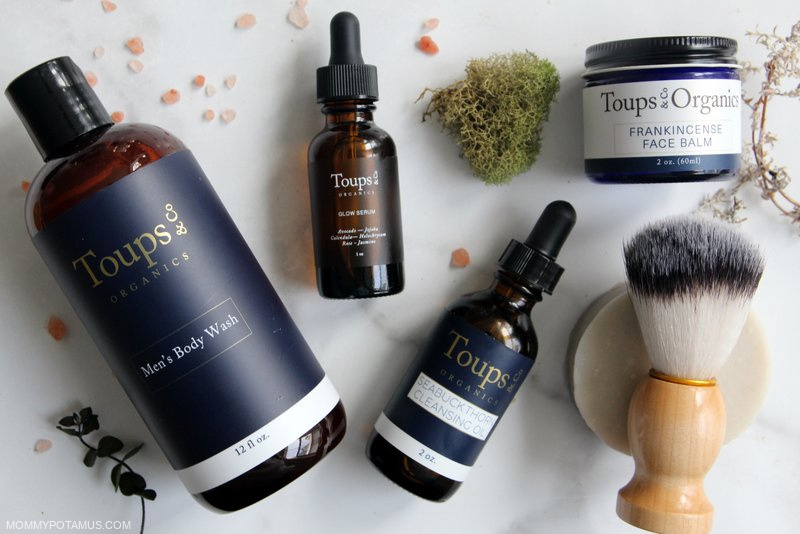
Toups & Co. Skincare + Makeup – If you’ve ever messaged me to ask if I plan to sell any of my DIY balms, deodorants, serums or soaps, you know that the answer has been “maybe someday” . . . . for years.
The timing has never been right, but fortunately my friend Emilie offers her own amazing formulations of many of the products you ask about most.
I’ve been a fan ever since she opened her shop, Toups & Co. Organics, with one luxurious blend – whipped tallow balm. Since then she’s expanded into a full face and skincare line, makeup, men’s products, and baby care . . . all made with high quality ingredients.
Since Toups & Co. is based in a coastal town not too far from mine, my daughter and I have had the opportunity to test a lot their products. In this article you’ll find a list of my favorites, plus a discount code if you want to try them out.
Sources
- Ecology Center (2019) Yoga Mats Testing Reveals Greenwashing: Environmentally Friendly Labeling of Some Yoga Mats Disguises Actual Composition
- Kuraray Elastomer. What is TPE?
- Navneet Soodj et. al. (2021) Studies on the effect of low density polyethylene on ethylene vinyl acetate/styrene butadiene styrene blends for yoga mat applications
- James Huff and Peter F. Infante (2011) Styrene exposure and risk of cancer
- G. Akovali (2012) Plastic materials: polyvinyl chloride (PVC)
- Abdul Qadeer et. al. (2022) Alternative Plasticizers As Emerging Global Environmental and Health Threat: Another Regrettable Substitution?
- Chun Z. Yang et. al. (2011) Most Plastic Products Release Estrogenic Chemicals: A Potential Health Problem That Can Be Solved
- Linda Chalker-Scott, Washington State University. The Myth of Rubberized Landscapes “Recycled rubber mulch is an environmentally friendly, non-toxic choice for landscapes”
- Agency for Toxic Substances & Disease Registry. ToxFAQs™ for 1,3-Butadiene
- The Conversation (2017) Many household products contain antimicrobial chemicals banned from soaps by the FDA
- FDA (2019) 5 Things to Know About Triclosan
- Jianan Zhang et. al. (2022) Microbial enzymes induce colitis by reactivating triclosan in the mouse gastrointestinal tract
- University of North Carolina (2022) A Common Antimicrobial Triggers Gut Inflammation
- Jenna Cartusciello (2022) This Chemical in Yoga Mats and Athletic Clothes May Trigger Gut Inflammation, Study Shows
- Jamie Ducharme (2017) Chemicals Found in Yoga Mats May Mess with Fertility, Study Says
- Courtney C. Carignan (2017) Urinary Concentrations of Organophosphate Flame Retardant Metabolites and Pregnancy Outcomes among Women Undergoing in Vitro Fertilization


